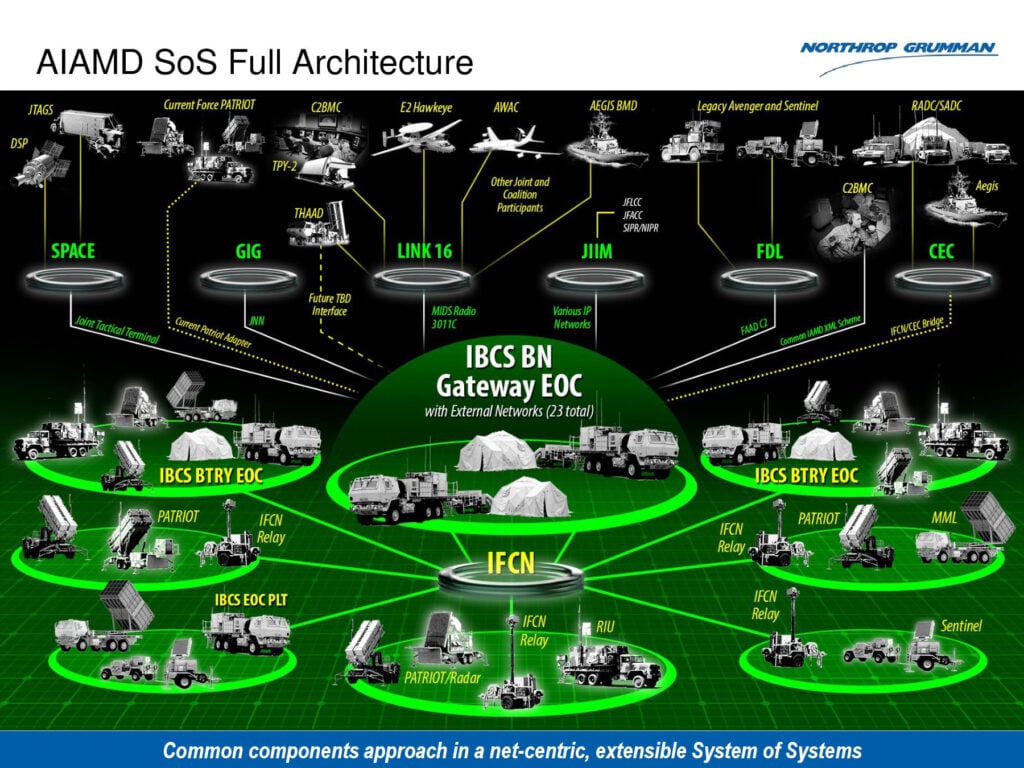
A simplified (yes, really) overview of the Army’s IBCS command-and-control network for air and missile defense.
WASHINGTON: The Army’s IBCS missile defense command and control system is still in testing. But in the not too distant future, it’s supposed to become a major building block for a future meta-system linking all the armed services, known as Joint All-Domain Command & Control. Can IBCS connect the Army, Air Force, Navy, and Marines? Yes, two generals told me — up to a point.
IBCS is the Army’s migraine-inducing nested acronym for IAMD (Integrated Air & Missile Defense) Battle Command System. The system has already proven it can connect to Air Force and Marine Corps radars, Maj. Gen. Robert Rasch and Brig. Gen. Brian Gibson told me, and it will connect to more joint systems in the future.
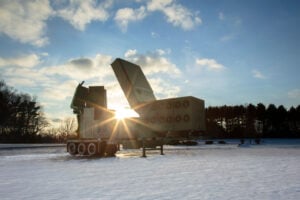
A full-size mock-up of Raytheon’s Lower Tier Air and Missile Defense Sensor (LTAMDS) radar, the first radar designed to be IBCS-compatible from the start.
But the highly specialized demands of air and missile defense require split-second timing and minimal network lag to shoot down incoming missiles. That means IBCS can never be all things to all users, even within the Army. And while IBCS will be able to give orders to a variety of Army radars and weapons — not just share data — the generals don’t expect the other services will give IBCS that kind of authority over their systems – and they think that’s probably wise.
“If I’m another service, am I going to allow IBCS to basically take over my radar? I think most other services would probably rather retain control of their radar for their purposes, but allow us to utilize the information,” Rasch told me. Each service bought the radars it has for specific missions, he said, and the Army neither needs nor wants to divert those radars from that original purpose.
Now, the Army definitely wants IBCS to see the data those radars are reporting.
“Let’s say you have a high-fidelity sensor in the air, you have a high-fidelity sensor on the ground, you have a high-fidelity sensor at sea,” Gibson told me. “In the past, you could only take advantage of one of those pieces of data”: For any given target, you’d have to decide which sensor’s track to trust, and which to ignore. With IBCS’s ability to fuse the best available data from multiple sources into a single track, he said, “in the future you can take advantage of more than one of those, and that data can then be shared.”
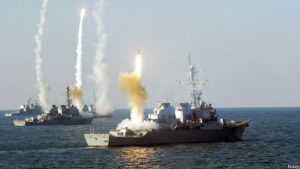
Aegis ships firing missiles
But connecting everything for everything isn’t always the right answer. Different missions still need different networks.
“If it’s available and it’s useful and there’s a connection, then there’s a choice to be made,” Gibson emphasized. “Sharing the right data with the right user at the right time, along latency timelines that are useful, is really where the trick to this puzzle lies.”
Latency – aka lag – is a crucial technical issue. All else being equal, the more users there are on a network, and the more data they share, the slower that data moves. For some purposes, such as planning long-term ground maneuvers, this doesn’t matter. Cities, roads and mountains don’t move, and while a lone tank might drive rapidly down a highway, historically a whole army moves less than a hundred miles a day, even in extreme cases like the 2003 invasion of Iraq. But if you’re trying to shoot down incoming missiles, especially supersonic or even hypersonic ones, being a fraction of a second out of date can mean you miss the target entirely.
“There are lots of sensors out there, not just air defense, that may contribute valuable information to the air picture,” Rasch said. “But those will be decided on a case by case basis, so as not to have any negative impact on the latency requirement for hitting a missile with a missile.”
“Our network has very tight latency controls based upon mission that we’re doing,” he said. “We don’t want to break anything on our network connecting it” to the wrong thing.
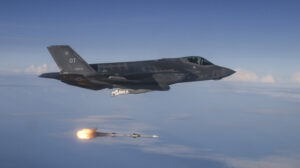
F-35A weapons test
The Hard Part
The Army’s already done experiments in which the Air Force F-35 fighter and the Marine Corps G/ATOR radar fed targeting data to IBCS, whose algorithms combined that data with other sources to accurately track the target. It’s also talking with the Navy about testing a link between IBCS and the fleet’s air & missile defense Cooperative Engagement Capability.
“We’ve done excursions – not formal and final integrations — with a variety of sensors … that have proven the ease of sharing the digital sensor information,” said Rasch, who as the Program Executive Officer (PEO) for Missiles & Space is responsible for developing, testing, and procuring the new network. “That has proven to be every bit as good as we thought.”
But an experiment is not a combat-ready capability, and there is as yet no timeline to integrate Air Force, Navy or Marine Corps sensors into the Army IBCS. In fact, there’s no timeline to integrate all the Army’s existing air and missile defense systems into IBCS.
“We are laser-focused on getting this baseline system fielded,” Gibson told me. “The baseline system will not be sacrificed to experiment with any other future integrations that might occur.”
So what’s that baseline? The Army currently plans to integrate three types of radar into IBCS:
- the numerous but relatively short-ranged (40-75 km) AN/MPQ-64 Sentinel;
- the longer-ranged (100 km) but less common AN/MPQ-53 and -65 used by Patriot batteries;
- and the new Lower-Tier Air & Missile Defense Sensor, LTAMDS, which will replace the Patriot radars.
LTAMDS is the first Army radar to be built from the start to be IBCS-compatible, while the others require retrofits.
What about the Army’s handful of high-powered AN/TPY-2 radars – just 10 are in service, with a range of up to 1,000 kilometers — used by the long-range, high-altitude THAAD missile defense system? What about the Ground-Based Interceptor, which the Army operates as part of the anti-IBCM defense for the United States itself?
So far, Rasch told me, there’s no funding to integrate either THAAD or GBI with IBCS in the current five-year budget plan, which runs through 2025. (The 2022-2026 plan is still being drafted, and given the trillions spent on COVID relief, Pentagon spending may be cut.) It takes time, money, and significant technical finesse to connect an existing system to IBCS.
First, Sentinel, Patriot, THAAD, and GBI were not designed to share data with each other in the first place. That means IBCS has to translate across multiple, incompatible formats.
Second, IBCS is asking for a lot of data of a type that existing radars weren’t designed to output at all. Normally, the input to a radar is radio waves bouncing off solid objects like aircraft and missiles; the output is the software’s best guess at what those objects are, where they are, where they’ve been, and where they might be going – what’s called a “track.” IBCS can take in tracks from multiple radars and compare them. But it works best when it can take in the raw data from those radars and pull it all together into a single “composite single,” one that takes the best available information from multiple sources and produces a result more accurate than any single radar, however good, could deliver on its own.
Third, IBCS doesn’t just share data: It can also send out commands. It can tell the radars on the network which way to look, ensuring maximum coverage of danger zones and minimal gaps. And it can decide which anti-aircraft or anti-missile weapon is best able to take out a particular threat, give it the targeting data, and order it to fire.
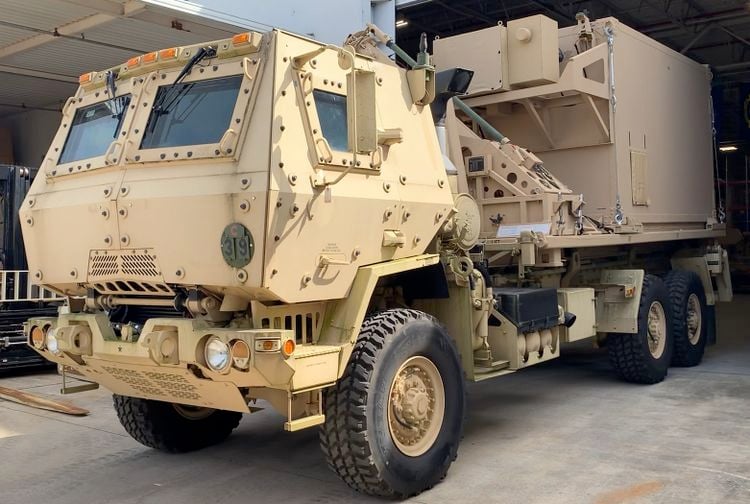
The mobile command post for the Army’s new IBCS air and missile defense network.
The other services probably won’t be comfortable giving an Army system that kind of control over their radars, let alone their weapons, although it’s technologically possible to do so. “For all the Army radars, it’s going to be a very deep level of integration where we’re going to be controlling those radars from an IBCS EOC [Engagement Operations Center],” Rasch said. While the Air Force and Marines have proven they can share data with IBCS, he said, “[they] probably aren’t going to be as keen on IBCS trying to direct their sensors.”
Even for Army systems, the IBCS software won’t have total control. Human beings will still make the decision whether or not to shoot. The algorithms – which, while sophisticated, don’t yet rise to the level of artificial intelligence – will recommend which weapons to use against which targets, but only a human can authorize those weapons to fire. Now, the human operator may define certain high-pressure situations where the weapons are pre-authorized to fire because human reaction speeds just aren’t fast enough to cope: say, if dozens of supersonic threats are incoming at once. But the criteria on which the computer can open fire be strictly limited, and a human will be at the controls with the ability to override a fire order at any time.
“Right now in the system, there is no hands-free mode,” Rasch said “Obviously, those algorithms could be developed easily, but it’s not in the current plan.”
“I can’t envision our user community will ever get to the point where they give the choice to an operator to take hands-off completely,” Gibson added.
“At the end of the day,” Rasch agreed, “we’re going to have air defense soldiers – informed by IBCS – make an engagement decision.”
In a ‘world first,’ DARPA project demonstrates AI dogfighting in real jet
“The potential for machine learning in aviation, whether military or civil, is enormous,” said Air Force Col. James Valpiani. “And these fundamental questions of how do we do it, how do we do it safely, how do we train them, are the questions that we are trying to get after.”


























